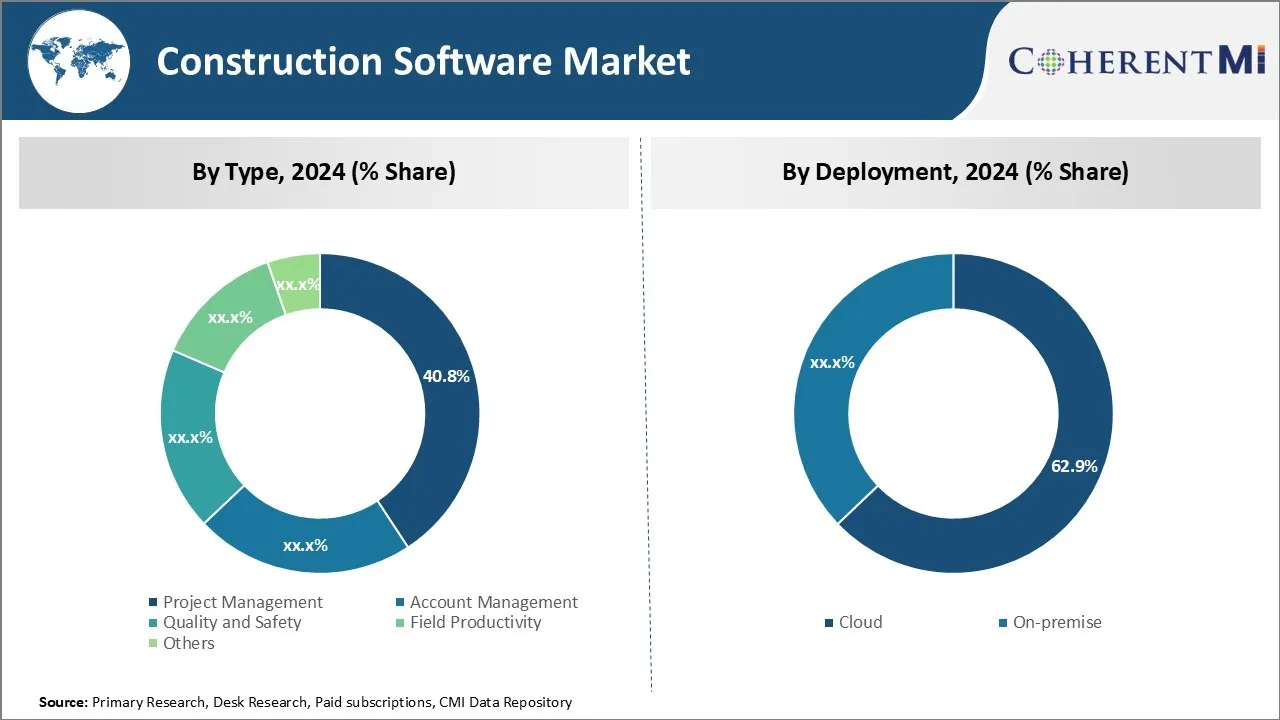Construction Software Market Trends
Market Driver - Rising Advancements in Smart Cities and Urbanization
As more and more people are moving to urban areas, the concept of smart cities has taken off rapidly in past few years. Smart cities utilize a variety of sensors, data collection tools and integrated technologies to maximize resource efficiency, reduce costs and enable better planning and management across various functions within a city. Construction sector plays a vital role in establishing smart infrastructure and building capabilities required for smart cities. With rising focus on initiatives like intelligent transport systems, smart energy grids, e-governance, environmental monitoring and adaptive infrastructure, construction companies are under increasing pressure to leverage latest construction technologies and software to cope up with the complex requirements of smart cities. Advanced technologies such as IoT, augmented reality, cloud computing and big data are being integrated into construction management and planning tools to improve productivity, coordination and quality control in large smart city projects.
Constructing smart buildings, transport hubs, utilities and public amenities involve handling enormous amount of project data from design to completion which requires robust and automated construction management systems. Therefore, software that helps streamline operations, oversee subcontractor coordination and enable real-time progress tracking across spatially distributed smart city projects have seen escalating demand from urban infrastructure developers. Intelligent software tools that facilitate multi-stakeholder collaboration, maintain design compliance and optimize resource allocation over the entire lifecycle of a smart city are strengthening the business case for construction companies investing in digital transformation of their processes. While still at a nascent stage, advancements in smart cities across major countries indicate strong potential for construction software market specifically engineered to deal with complexities introduced by intelligent urbanization initiatives globally.
Market Driver - Increased Demand for Better Construction Management Tools and Automation
Construction industry has always grappled with issues related to project delays, cost overruns, quality discrepancies and inefficient resource management attributing largely to fragmented nature of operations and lack of integrated systems. However, growing awareness about potential of latest digital technologies as well as client pressures to adopt advanced practices have compelled construction firms to seek innovative software driven solutions to enhance performance. In addition, shortage of skilled labor aggravated by aging workforce has accelerated adoption of tools enabling work automation, remote monitoring and augmented operations. Construction project management software equipped with features like 4D BIM integration, predictive analytics, damage detection, automated scheduling, cash flow forecasting and remote tracking are helping stakeholders achieve better outcomes. Meanwhile, construction firms are also leveraging cloud-based solutions for collaborative documentation, real-time progress updates and paperless transactions across project sites. Focus on automation is increasing with robotics, AI and sensor driven systems finding applications in activities like 3D printing of structure components, autonomous vehicles for material transportation, drones for surveying and robotic inspection bots for safety checks. Such automated approaches promise enhanced safety, standardized quality and accelerated timelines. With growing complexity and scale of modern construction undertakings, sophisticated management tools that optimize resource use through automation and aid data backed decision making have become indispensable for maintaining competitiveness in the industry. Their ability to minimize delays, curb job site errors and maximize overall workflow efficiency is fueling significant demand and market opportunities.

Market Challenge - High Cost and Time of Deployment of Construction Software
The high cost and lengthy implementation time required for construction software solutions presents a significant challenge for adoption in the industry. Full-featured construction management platforms with modules for scheduling, budgeting, procurement, project collaboration and more require substantial upfront investments. Integrating these systems also takes time as existing business processes and data need to be migrated. This level of cost and disruption can be difficult for smaller construction firms and contractors to absorb. Additionally, the return on investment for software is not always immediately clear and quantifiable. Companies may be hesitant to dedicate extensive resources without guaranteed improvements in efficiency, cost savings or other measurable benefits. Overall, the high price tag and time commitment associated with deploying new construction software limits its adoption, particularly among smaller players.
Market Opportunity: Emergence of New Technologies like AI, Virtual Reality, and 3D Printing in Construction
The increasing application of technologies such as artificial intelligence, virtual reality and 3D printing within the construction industry presents significant opportunities for software vendors. New platforms that leverage AI have the potential to automate routine tasks, gain insights from massive amounts of project data, and enhance project management, scheduling and risk assessment. Applications of virtual and augmented reality allow contractors to visualize designs in 3D, flag and resolve issues virtually before construction begins. In addition, 3D printing technologies enable on-site fabrication of customized construction components, reducing waste. Construction software companies who develop solutions that integrate these emerging technologies stand to gain competitive advantages. They can offer contractors productivity improvements, cost reductions and safety benefits that help boost revenue and provide stronger returns on software investments. This makes their value proposition during the sales process much more compelling.